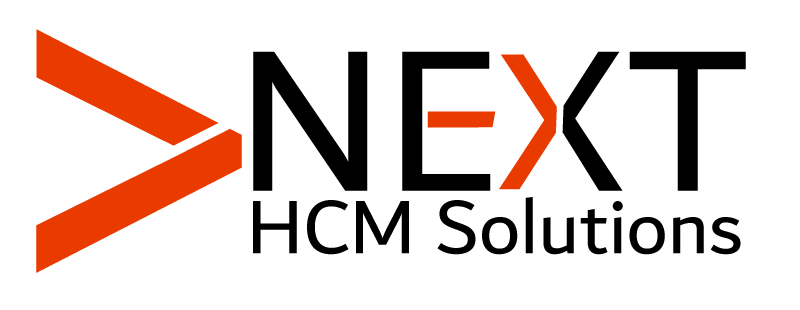Join the Best Workday Training in Bengaluru to Learn, Practice and Suceed
Workday Adaptive Planning Tutorial
Training Blueprint
Perception Workday Adaptive Planning
The use of Workday Adaptive Planning is the choice of companies that wish to clarify their financial and operational planning This constitutes its structure and features that we will take a closer look at Workday Adaptive Planning Tutorial in Bengaluru to perceive the full capacity of a tool.
To operate in Workday Adaptive Planning with the first suitable support elements such as levels, currencies, accounts, and features is a must.
These key elements are a must for the forethought of the planning structure Once they are prepared, you can develop an excellent model that is not only aligned with business but also meets the needs of the business
Building Levels in Workday Adaptive Planning
Workday Adaptive Planning levels are a representation of a company’s internal organization or organizational hierarchies
Structuring the data becomes very easy by tagging these levels to different stores across different countries or departments inside a company.
The indispensable conditions to be met to form a level in Workday Adaptive Planning Tutorial in Bengaluru include data organization and streamlining and these can be achieved by the correct mapping of the levels.
Creating Properties and Accounts
The storing of financial data is the function carried out by accounts in Workday Adaptive Planning, while on the other hand, traits are employed to the financial data for the purpose of tagging and categorization.
Fetching a superior cognizance of characteristics usage in Workday Adaptive Planning will make the users more confident when tracking their financial performance as this truer tracking can also be converted into strategic planning of the organization’s different levels.
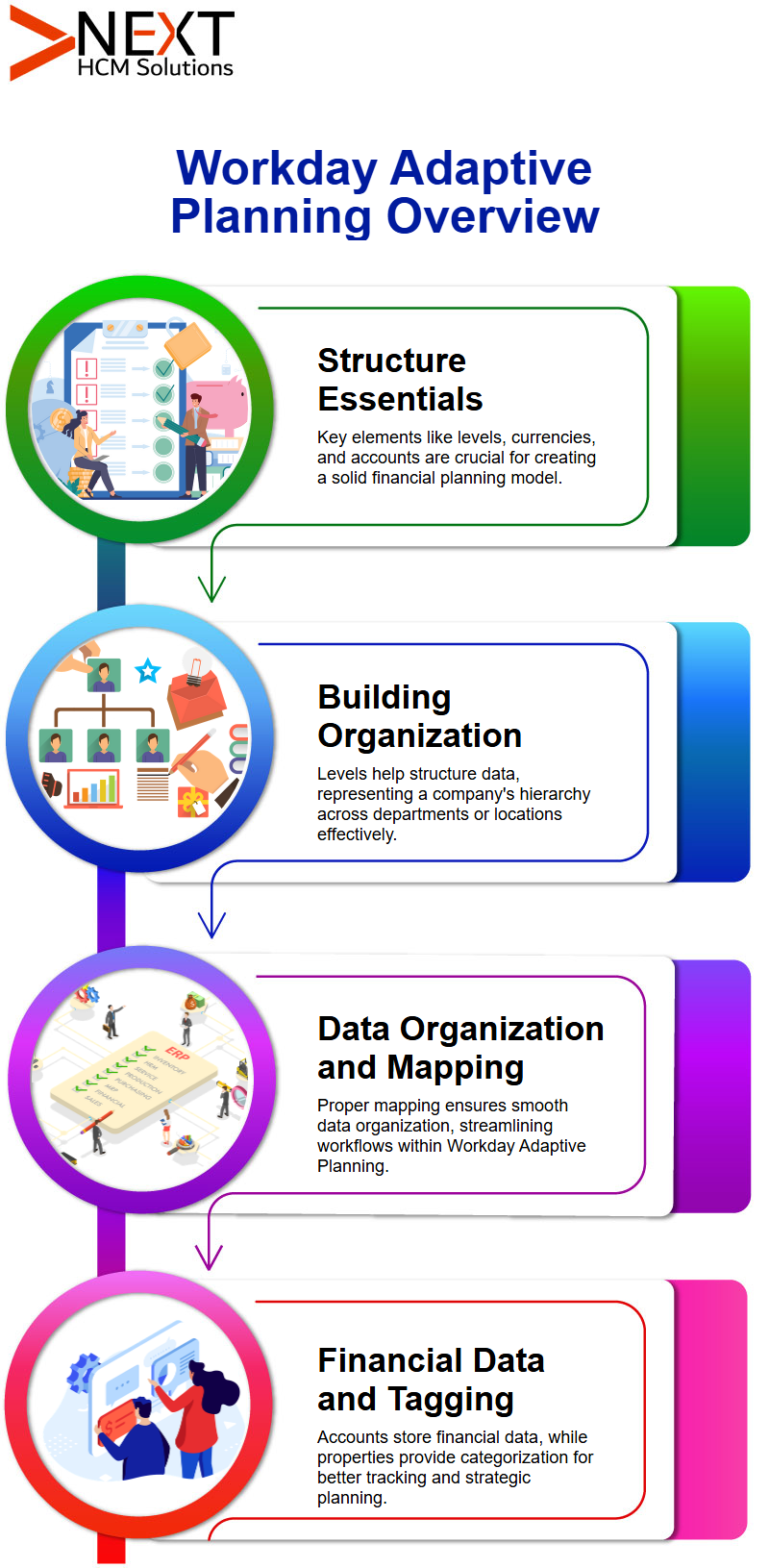
Examining Standard and Cube Sheets
Workday Adaptive Planning presents three categories of sheets: standard, cube, and modelones. These can be observed in Workday Adaptive planning Tutorial in Bengaluru.
Standard sheets in Workday Adaptive Planning enfold elementary elements such as accounts, periods, versions, and levels.
In contrast, cube sheets broaden the range through the inclusion of additional dimensions and features that make them the best choice for knotty financial modeling.
Insight Workday Adaptive Planning
Workday Adaptive Planning, a financial modeling application is a multi-talented system that helps organizations in their planning and projection processes.
Today, releases learn about the vital components of the model standard sheets and cube sheets and Authorize’s find out their differentials if any.
One of the questions most asked is around the cube sheets and standard sheets – what is the difference? The answer to the question with explanation can be dealt in Workday Adaptive Planning Tutorial in Bengaluru,
When you generate a cube sheet in Workday Adaptive Planning, you are tackling data which has multifaceted calculations and is multi-dimensional. Standard sheets, meanwhile, are a lot easier than that in that they follow a set structure.
Role of Dimensions in Workday Adaptive Planning
Dimensions used in Workday Adaptive Planning contribute to a consistent and systematic data relationship.
Properties assigned for encoding are different from dimensions that are usable by users for improved data organization and analysis.
Having an obvious vision of when and where to use dimensions rather than characteristics in Workday Adaptive Planning is an indispensable prerequisite for exact reporting.
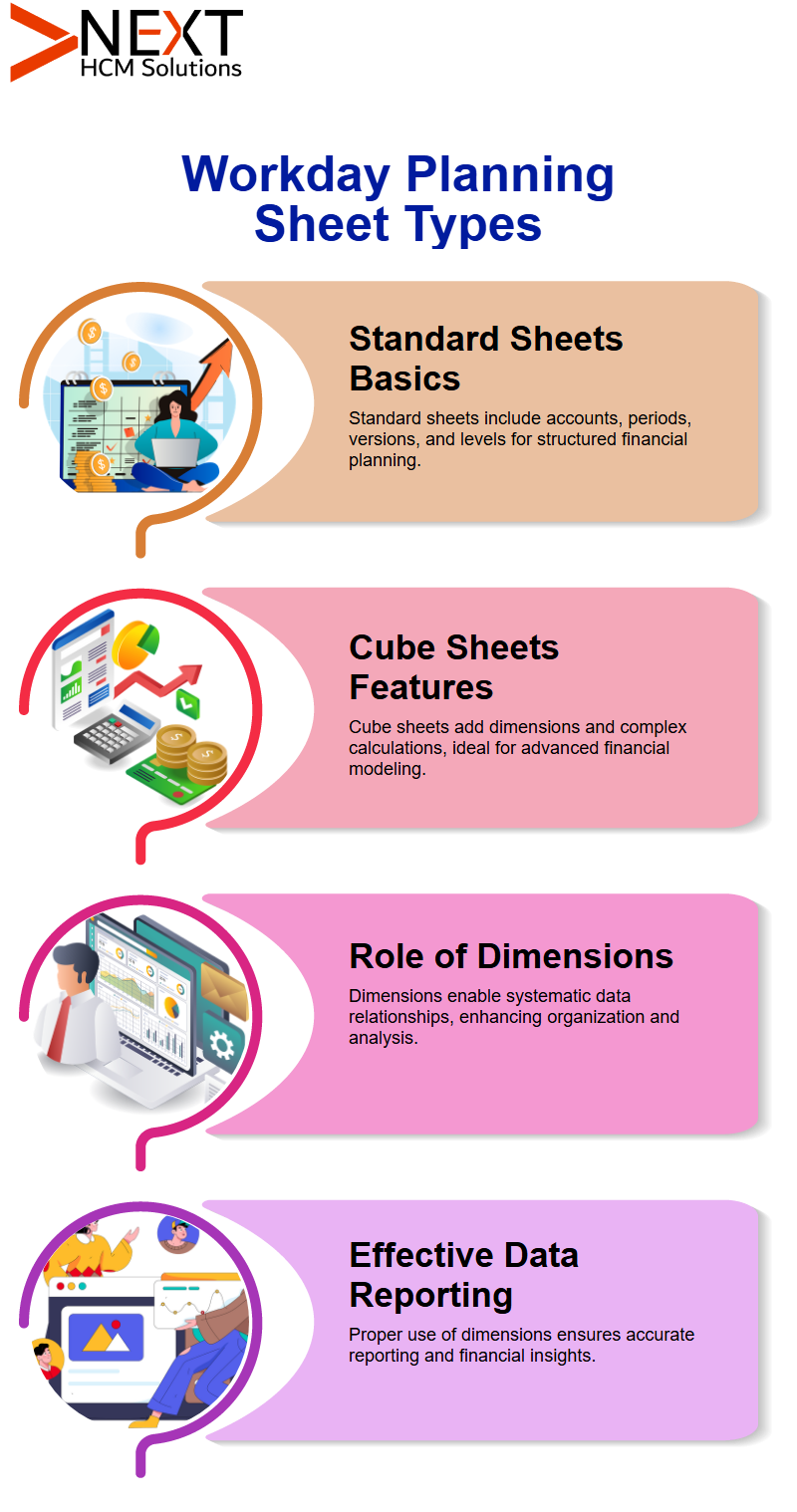
Dwelling Sheets in Workday Adaptive Planning
Fluctuations in the versions, as well as the set of levels and dimensions, bring together a layout which is most fitting for a given organization.
We use two types of sheets, these are level-assigned and user-assigned ones. Level-assigned sheets have their names closely related to the levels, that is, the availability of these sheets is limited based on the hierarchy.
The kinds of access to user-assigned sheets are different. To achieve the objective of having only one person, for case, Rene, to access a particular sheet, the assignment is made at the user level rather than the broader level hierarchy.
Security and Confidentiality in Workday Adaptive Planning
Security features have a great impact on the performance of Workday Adaptive Planning.
One of the difficulties of working with a team that shares data is to keep the empathetic data safe and still retain the imperative level of interaction.
This is where level-assigned sheets come into entertain for illustration, if we have multiple regions in our organization and want only certain ones to access a sheet, we can restrict it accordingly.
Workday Adaptive Planning Controls Accounts and Hierarchies
Workday Adaptive Planning crowds its main performance in the area of Accounts, where the knowledge of them aids as a backbone in achieving a productive dais usage.
The three components calculated accounts, metric accounts, and routine accounts in Workday Adaptive Planning Tutorial in Bengaluru are provided for writing a formula and structuring the data quite similar to Shine sheets.
Each has a separate function, so the users are more than welcome to choose the most decent.
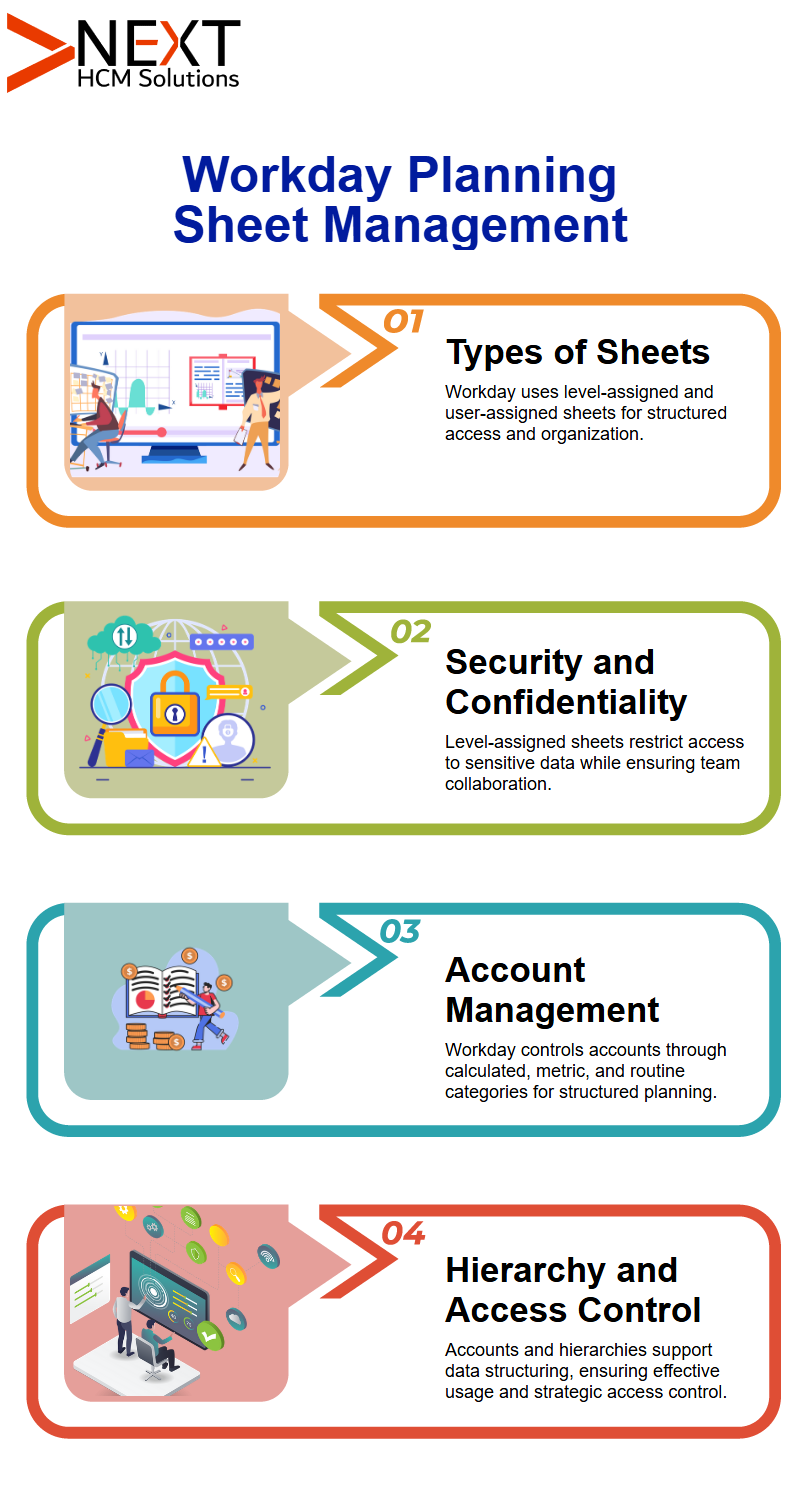
Financial Models with Workday Adaptive Planning
You will be more informed as to how Workday Adaptive Planning operates, and you will know how financial models can be skillfully managed by means of it
Workday Adaptive Planning enables businesses to simultaneously have a clearly defined and flexible structure through cubes and standard sheets while keeping the data error-free.
During the transformation, the stage refines and improves data persistently.
Set the Time and Versions in Workday Adaptive Planning
Changing time settings is handled lucid and easy in Workday Adaptive Planning Even features may not be available in a demo tenant, still, month-wise defaults greatly uncomplicate the process.
Consolation is another of the strong points of Workday Adaptive Planning Tutorial in Bengaluru.
By prompt tracking revisions from one fiscal year to another, businesses are 100% sure that the planning sequence has the straightest lane to success.
Creating Structure of Groups and Chains
It is very easy to set up the hierarchy structures in Workday Adaptive Planning. No matter which location we work with, we can always explain the levels like, India, Mumbai, or structures can be expanded over assorted locations, the tool will keep the continuity.
By naming levels in a methodical manner, error is made lesser, and confusion is minimized. Workday Adaptive Planning confirms that organizations are able to classify their data in a more truthful and productive way, thus, chief to systematic decision-making.
Account Structures in Workday Adaptive Planning
Once the accounts are defined, the import process makes setup quick and productive.
This is the next important step in Workday Adaptive Planning Tutorial in Bengaluru simply managing the accounts without affecting the original data Appreciation the difference between GL accounts and customer accounts is a key point
Naming conventions are such an important rule because equivocation can be best kept away by that.
In the same way, Workday Adaptive Planning refines this process, making sure that financial data is structured and formulas are ready to be used without error for future calculations.
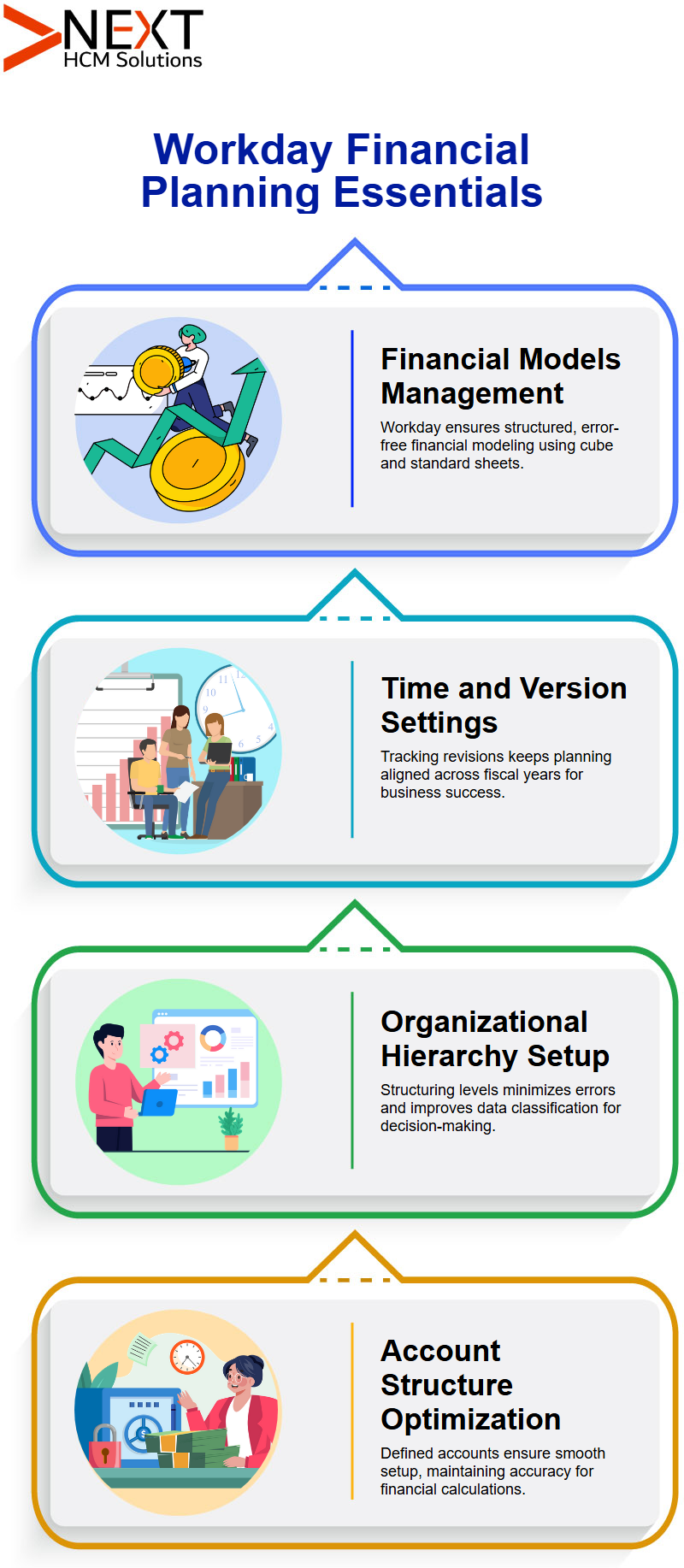
Dwelling a Standard Sheet in Workday Adaptive Planning
A standard sheet creation is really easy in Workday Adaptive Planning
Users are able to start performing data structuring in the modeling section and the respective allocated levels of the sheets.
One of the most key parts of the process good, model, or cube is the choice of the right type of sheet that Workday Adaptive Planning arrangements giving the opportunity to the user to make variations in the sheet structure according to their planning mandates.
Workday’s Adaptive Planning for Powerful Data Management
For instances, Workday Adaptive Planning is an outstanding when it comes to business planning tending Ranging from lowering roll-ups modifications to the facilitating of the account setup sequence, the software is well-packed with features that are very simple to use.
Moving forward with the tools that come with Workday Adaptive Planning Tutorial in Bengaluru, companies can take care of the automation and betterment of finance in the budgeting processes hence, experience a complete leaner operation.
Financial Planning with Workday Adaptive Planning
Workday Adaptive Planning is a required instrument which makes the process of the financial planning and the analysis easy to provide any kind of help, this dock does it in the simplest mode, be it byzantine data or the management of company finances.
The most important thing about Workday Adaptive Planning is dropdowns How can you sum up all the values, find the average, or achieve weighted averages?
These three operations are essential in a well-timed, relevant, and correct financial projection
Workday Adaptive Planning and Data Types
In the case of Workday Adaptive Planning, having the knowledge of different data types becomes a major thing by default, accounts are monthly-based, thus safeguarding the monthly aspect of financial plans.
Each sheet has a monthly structure, which also helps in trend and pattern analysis.
The allocation of data in Workday Adaptive Planning licenses for availableness. If a certain account is connected with numbers, then that is what you call it.
In case of currency, then you specify it as such. This flexibility in Workday Adaptive Planning Tutorial in Bengaluru makes sure the financial reports are exact.
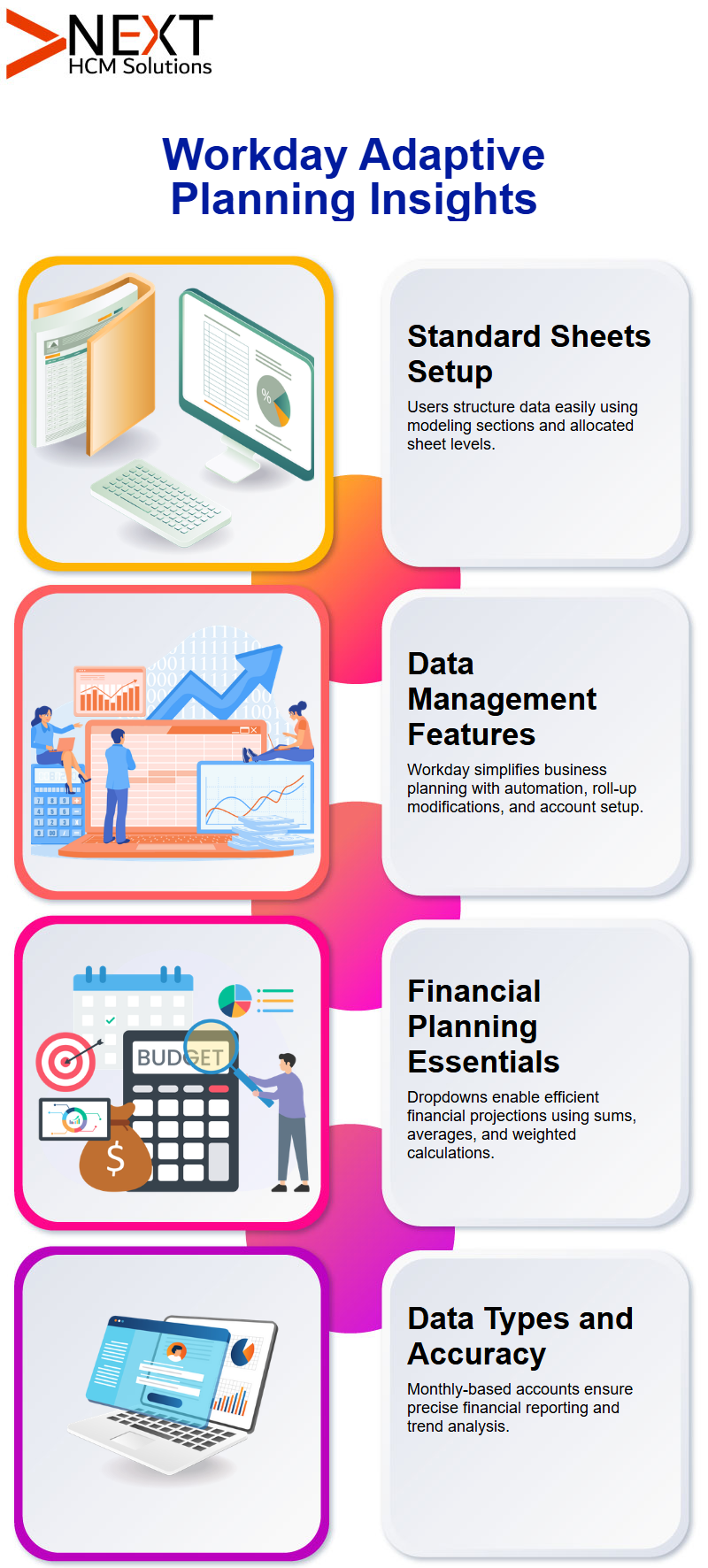
Financial Management with Adaptive Planning Tools
Workday Adaptive Planning grants one to have an ‘actual overlay’ which means that the evidence from the last period can be brought into the new period.
When enabled, the historical data becomes visible in the models, thus, appreciation the developments in the financial sector becomes in-depth.
With this characteristic, it is now very easy for an organization to be able to supervise their financial records.
Workday Adaptive Planning is a tool that enables one to keep circuit of previous figures and at the same time, implement new financial methods.
Trade of Currencies and How Workday Adaptive Planning Benefits
Replace rates are very much a part of financial planning in Workday Adaptive Planning is where most businesses decide to go for the direct balance sheet flows or monthly averages Adaptive Planning has default settings in place so as to affirm data fidelity at all times.
The organization also has the option of changing the settings if they find the default settings not up to their outlook.
This regularity nullifies the existence of errors and miscalculations, making Workday Adaptive Planning a correct instrument for financial prediction.
Data Privacy Management in Workday Adaptive Planning
Workday Adaptive Planning is committed to certifying that the data privacy quantifiers remain unbreeched.
The method of role-based access control is the safest as it licenses only chosen people to access exact data sets, and at the same time, it restricts the access of others.
Speaking of a case, Thomas is supposed to be provided with the facts relating to Mumbai, Bangalore, and Chennai.
On the other hand, Renesh has the requirement of having the data of centers which are New York, Philadelphia, and Chicago.
If it is so, then the Workday Adaptive Planning will activate the possibility to divide the data only according to the exact location and the exact users
Financial Management with Workday Adaptive Planning
Workday Adaptive Planning is a powerful tool designed to simplify and enhance financial management processes.
One of its core strengths lies in the effective use of attributes (or tags), which act as the linchpin in organizing and categorizing accounts properly.
For example, tagging salaries and wages correctly as expenses ensures accurate financial tracking within the system.
Attributes serve as identifiers similar to account numbers and can represent different levels, accounts, or dimensions such as tasks or units.
This structured tagging enables quick summarization and visualization of key account groups like revenue or cost of goods sold (COGS), improving financial reporting efficiency. Instead of manual formula writing, users can effortlessly generate reports thanks to attribute-based grouping.
The system supports easy error correction and structural updates misspellings or attribute changes can be quickly amended and reflected with a simple screen refresh.
Bulk imports and pre-structured templates allow rapid account creation and maintenance, easing the setup and ongoing refinement of financial structures.
Filtering options in reports further streamline the user experience, enabling financial analysts to gather precise business insights without manual effort.
However, successful implementation requires a clear understanding of company requirements upfront to avoid unnecessary restructuring or workflow disruptions.
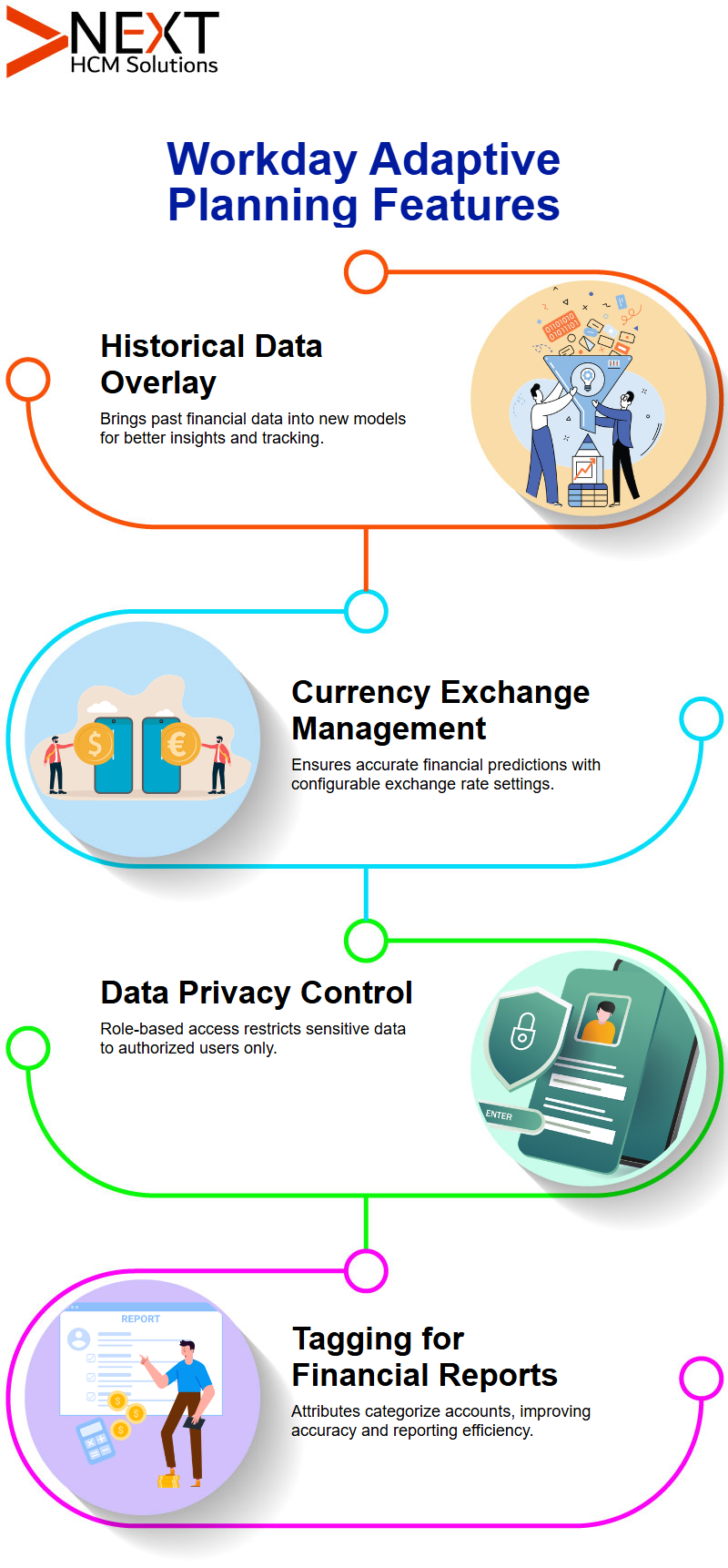
Workday Adaptive Planning Essentials
Proper account attribute setup is crucial for smooth financial workflows and accurate analysis, especially for businesses transitioning from other platforms like Top.
Correct mapping of account traits to financial conditions ensures hassle-free operations.
When updating financial structures, it’s important to avoid unnecessary full account reloads, as these overwrite all existing data and may disrupt reporting.
Users should verify template columns before import, relying on provided instructions to distinguish mandatory and optional fields, which supports precise data management.
Workday Adaptive Planning not only aids in structured account management but also enhances financial planning by aligning data with organizational goals.
This clear and well-organized account setup leads to improved business insights and more informed, data-driven decisions.
Workday Adaptive Planning Tutorial in Bengaluru delivers financial clarity and efficiency through its flexible, attribute-driven approach, empowering financial planners to break down revenues and expenses in a way that supports strategic business growth.
Preparing and Managing Data in Workday Adaptive Planning
One of the most important elements of Workday Adaptive Planning Tutorial in Bengaluru is to make sure that the disciplines that should be kept obligatory are really filled in because failure of a user to populate the indispensable sectors can result in errors, which is why it is imperative to give it a rethink before advancing.
Workday Adaptive Planning makes this task easier for users and thus, users are allowed to upload data where there is already a structure, without disturbances.
Next, the accounts will be developed and brought into Workday Adaptive Planning.
As a first step, it must be ensured that the relevant data terrains are entered correctly so that the structure is in line.
Upon using Workday Adaptive Planning, each account is grouped with the relevant roll-up structure that leads to easier and useful financial management.
The step of data formatting in Workday Adaptive Planning must not be omitted because it’s the most important.
If labels such as ‘Cumulative’ or ‘Periodic’ are part of the layout, they are mandatory to be created before running the import process.
Budget managers can use examples of Workday Adaptive Planning to illustrate the use of the transform tool to update multiple accounts in the system itself without having to extract data from the respective system, thus saving time.
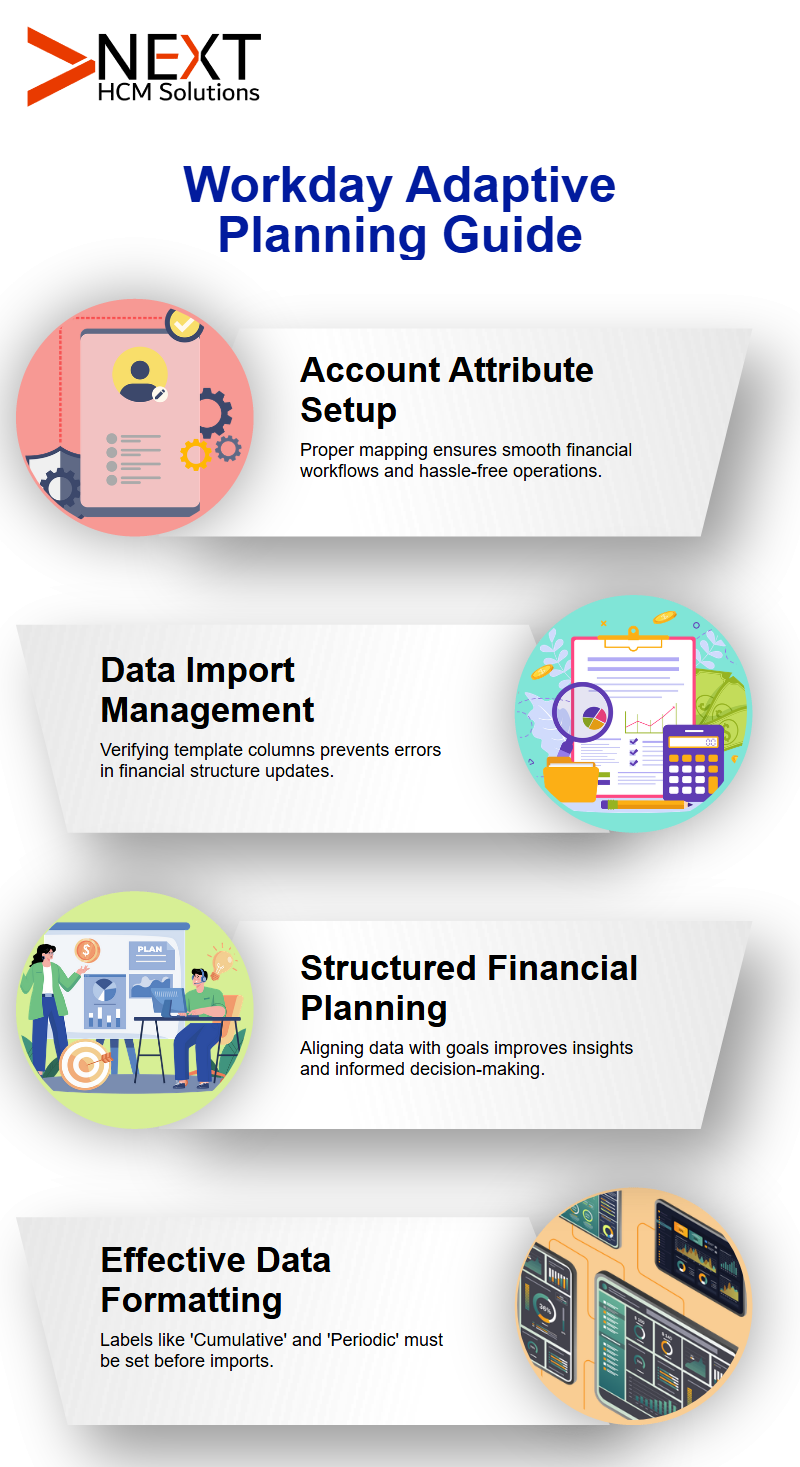
Workflows and Reporting with Workday Adaptive Planning
The topic of data characteristics in Workday Adaptive Planning will now be addressed.
The fact is that the majority of people forget to sanction for the qualities which might be of different types such as ‘income’, ‘expense’, etc., when they are accompanied by the account names.
Users can attach missed details afterward with the help of Workday Adaptive Planning without re-entering all values.
This not only reduces redundancy but also speeds up the financial planning process.
It is also easy to validate data with Workday Adaptive Planning. Identifying a mistake in an import and verifying a template is a flawless way to correct the issue.
Furthermore, Workday Adaptive Planning Tutorial in Bengaluru is capable of reducing the time lag in the financial data process thus strengthening data exactness and integrity in real-time.
The financial reporting part inside Workday Adaptive Planning will also be dwelled on.
Up to the moment the account structures have been built, Workday Adaptive Planning has an aspect of exporting the most wide-ranging and printable reports to the CFO.
This, in turn, empowers the CFO to scan the account structures comfortably.
By combining Workday Adaptive Planning and data import, there is an expedient and sustainable use of resources while employing Outperform sheets for the planning process indeed takes quite a long time.
Workday, the process of uploading the data is completed within a very short period, thus sponsoring large financial operations.
From the examples shown in this counsellor, it is evident that Workday Adaptive Planning in fact, make account structure easier and greatly influence the financial workflows of the company.
By learning Workday Adaptive Planning from Workday Adaptive Planning Tutorial in Bengaluru both users and IT can put updates on autopilot, optimize the aggregate reporting process of the company, and have error-free financial data imported.

